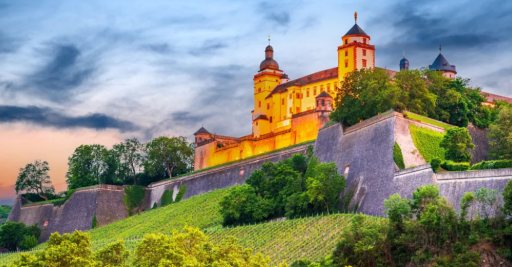Call us or email us if you have any questions.
Charming cities & rich traditions
Sail through southern Germany along some of Europe’s most iconic waterways. Explore the quaint villages of Bavaria and Baden-Württemberg and discover the turreted castles, abundant vineyards and the sweeping scenery of the Middle Rhine—a UNESCO World Heritage Site. Explore Koblenz and Cologne, two cities renowned for their rich history and striking architecture. Visit Kinderdijk to glimpse the idyllic 18th-century windmills that dot the countryside.

Nuremberg, Germany / Amsterdam, The Netherlands
2026 Sailings in June
* Please check with us for dates & pricing
Cruise fare from $5,299.00 per person
* Please check with us for dates & pricing

Nuremberg, Germany
Embark your ship and settle into your stateroom. The second-largest city in Bavaria, Nuremberg is filled with traditional half-timbered houses and Gothic churches with intricate spires. Although nearly destroyed during World War II, the remaining medieval city walls stretch some three miles and feature original gateways and 80 original watchtowers. Nuremberg is well known historically for its metal and toy craftsmanship. But it is infamous for its role in World War II, first as the site of Zeppelin Field’s Nazi rallies and later as the site of the war crimes trials at the Palace of Justice that captured the attention of a generation.
Bamberg, Germany
Founded in 902, Bamberg remains a medieval-looking city known for its symphony orchestra and rauchbier, specialty smoked beer. The city’s winding streets are filled with baroque patrician houses and are home to the stunning 11th-century Cathedral of Holy Roman Emperor Heinrich II, housing his tomb and that of Pope Clement II. Bamberg is especially noted for its Altes Rathaus, or Old Town Hall, situated on a twin-arched bridge over the Regnitz River, and for the old bishop’s houses: the 16th-century Alte Hofhaltung (Old Court) and 17th-century Neue Residenz (New Residence).
Shore Excursions – Bamberg Walking Tour
Duration: 4 hours 30 minutes
Delve into the history of Bamberg during an informative walk to view historic sights. Join your guide and head to the medieval city center, a UNESCO World Heritage Site. Pass by the magnificent 11th-century cathedral with its four imposing towers. The church was rebuilt in the late Romanesque and early Gothic style during the 13th century. Stop to admire the detailed statue of the Bamberger Reiter, or Bamberg Horseman, here. Then, see the Bamberg New Residence with its rose garden and panoramic views of the old town, as well as the picturesque Rathaus, or town hall, built in the middle of a double-arched bridge over the Regnitz River. From here, you can see fishermen’s cottages on the nearby riverbanks. Enjoy time to follow your own whims in Bamberg, perhaps sampling some of the town’s distinctive rauchbier, or smoke-flavored beer, before rejoining your ship.
Würzburg, Germany
Surrounded by Franconian vineyards, Würzburg was heavily damaged during World War II, but has since been completely restored. This prestigious university city is a jewel of baroque architecture. Its most pristine example of pomp and glory is the great Bishops’ Residenz palace, built in 1744 for the prince-bishop; his unwavering support of artists is evidenced by the sweeping staircase and magnificent ceiling frescoes by Tiepolo. Other landmarks include the medieval, statue-lined Old Main Bridge and Marienberg Fortress, originally a Celtic hill fort and later residence of the bishops. The city remains a major wine-making center, hosting Germany’s oldest and largest vineyard.
Shore Excursions – Würzburg Residenz & Walk
Duration: 3 hours
Tour Würzburg’s Bishops’ Residenz, one of Germany’s ornate palaces and a UNESCO World Heritage Site. Drive with your guide to the former residence of the Würzburg prince-bishop that was built over a 25-year period, beginning in 1719. Admire the overhead ceiling with its stunning, 6,400-square-foot “Four Continents” fresco painted by Venetian artist Giovanni Tiepolo. You will see several of the building’s ornate rooms, the colonnaded chapel and the baroque and English-style gardens lined with ornate statues. A highlight is sure to be the Mirror Cabinet. Incredibly, the entire complex was meticulously reconstructed after suffering extensive damage from World War II bombing. Afterward, continue to the Old Town of Würzburg, where a walking tour shows you the stunning Romanesque Cathedral, the Neumünster church, the market square and Town Hall, and the oldest wine bar in town.
Wertheim, Germany
Situated at the confluence of the Main and Tauber Rivers, Wertheim is a charming town brimming with history. The dukes of Wertheim built a castle at this strategic spot in the 12th century. It was captured and destroyed during the Thirty Years’ War, but it is still impressive today, peering down upon the medieval town center and half-timbered houses from its perch. Its Pointed Tower has guarded the junction of the Main and Tauber Rivers for 800 years. Known as a successful merchants’ town during the Middle Ages, today Wertheim is famous for its Franconian wines.
Shore Excursions – Wertheim Walking Tour
Duration: 1 hour
Explore Wertheim, a tiny town that has played a strategic role at the confluence of the Main and Tauber Rivers. You will join your guide to experience this quaint village, squeezed into a narrow triangle in the shadow of Wertheim Castle. As you stroll, its red sandstone towers and fortifications mark your progress from their perch, striking a dramatic pose against the lush hillside forest. You will walk past the Pointed Tower, round at the bottom and octagonal at the top. Over its 800 years, it has tilted to one side. Amble among beautifully restored half-timbered houses built in Franconian style. At the historic marketplace, you will pass a bakery and butcher shop, where you may stop after your tour to learn more about how these important professions help uphold German traditions. You can also stop by a glassblowing shop to admire the intricate works.
Scenic Sailing: Main River, Spessart
Journey along one of Germany’s most important waterways today, passing landscapes that embody the country’s scenic beauty and storybook charm. You will sail by quaint riverside villages, undulating farm country and the sylvan forests of the Spessart woodlands. Along the way, you just may lose yourself in the dreamy canvases of half-timbered houses, historic castles and splendid palaces. This is the Germany once ruled by dukes and brought to magical life by the imagination of the Brothers Grimm, who grew up in the town of Hanau and wove fantastic tales from these banks.
Scenic Sailing: Middle Rhine
The Rhine River flows through one of Germany’s most scenic regions. As you sail its most picturesque stretch, the UNESCO World Heritage Site of the Middle Rhine, you will pass vineyard-blanketed hills whose steep slopes require vintners to pick grapes by hand, keeping a centuries-old tradition alive. Splendid castles line the banks, all of which have stories to share, and the Lorelei Rock presides at a dramatic curve in the river. This infamous river maiden mesmerized sailors with her song and lured them to their demise at her feet.
Koblenz, Germany
Koblenz is a traditional German city, founded more than 2,000 years ago. This former trading settlement rests on a massif of the Middle Rhine Highlands. Its cobblestone streets, wood-beamed houses adorned with flowers, ancient market square and medieval churches recall the fairy-tale Germany of old. At the German Corner, a massive equestrian statue of Prince William I observes the lovely riverside scene. The famed Teutonic Knights set up their first base here in 1216. The Romanesque Basilica of St. Castor, Koblenz’s oldest building, dates to 836.
Shore Excursions – Historic Koblenz
Duration: 2 hours
Take a leisurely stroll around Koblenz and explore its historic past. You will meet your guide and begin your tour at Deutsches Eck, the city’s famed German Corner. Jutting into the waters like the prow of a ship where the Rhine and Moselle Rivers meet, this public park is home to a popular equestrian statue of Emperor Wilhelm I. After time to admire the sculpture, continue your walk among the narrow streets. Visit Jesuitsenplatz, or Jesuit Square, in the heart of the Old Town and named after the religious order of the same name. Admire the beautiful old school that sits on the eastern side of the square, and has been used as Koblenz City Hall since 1895. As you explore, your guide will point out influences from ancient Rome, the Middle Ages and the Napoleonic era.
Cologne, Germany
Cologne reveals its Roman heritage in its city layout and the ancient ruins that lie scattered through the town. Cologne’s modern plazas and Hohe Strasse host welcoming shops, enticing restaurants and cologne boutiques. Of note is the city’s 13th-century cathedral, a stunning example of Gothic artistry and a UNESCO World Heritage Site. Having survived Allied bombs during World War II, the cathedral’s imposing twin spires are visible for miles and its stained glass windows fill the interior with brilliant colored light. Its steps lead to a platform with astounding views.
Shore Excursions – Cologne Walking Tour
Duration: 2 hours
Learn about Cologne’s heritage and view its iconic cathedral, towering over the city in all its Gothic splendor. Step into a rich past, following the city’s preserved historic street patterns and hearing about its Roman and medieval history along the way. As you stroll, your guide will regale you with tales of local folklore figures, Tünnes and Schääl, and the city’s flourishing Jewish community. In Old Cologne, pass the elegant silhouette of St. Martin’s church and stop to view Cologne’s magnificent Gothic cathedral, a UNESCO World Heritage Site. Construction of this towering structure began in 1248 and continued in stages over the next seven centuries. The largest Gothic cathedral in Northern Europe, this magnificent church boasts two soaring spires and beautiful stained-glass windows, and survived the Allied bombings that ravaged the city and the rest of Germany during World War II.
Kinderdijk, The Netherlands
Kinderdijk is a village community in the Alblasserwaard province. This corner of South Holland, part of the scenic Waal and Merwede regions, has long been shaped by Rhine Delta waters. Kinderdijk is most known for its 19 remarkably preserved 18th-century windmills. The charming hamlet is located amid low-lying polders, tracts of land reclaimed from the sea by the power of the windmills and enclosed by embankments, or dikes. This legendary place calls to mind the 1865 novel Hans Brinker, in which a heroic boy plugs his finger into a ruptured dike.
Shore Excursions – Kinderdijk Windmills
Duration: 2 hours
See the picturesque Dutch countryside and the original technological marvels of historic Kinderdijk. You will walk with your guide into the serene polder lands of South Holland. As you cross the dike to the windmills, you will notice that they in fact are at a lower elevation than your ship, as much of this part of The Netherlands is below sea level. Built in the mid-18th century, these 19 windmills, the largest concentration in The Netherlands, stand like sentinels on a hushed landscape. You will learn why they were built and see firsthand how they work, even stepping into a working windmill to observe its mechanics and living quarters. Families who live in these mills are required to keep them in working order. This excursion provides a revealing look at these marvelous buildings that helped shape the legendary Dutch landscape.
Amsterdam, The Netherlands
Bid farewell to your fellow guests and journey home. Or spend more time exploring, perhaps joining one of our extensions.
*6 Guided Tours: One shore excursion included per port; all others available at an extra charge.